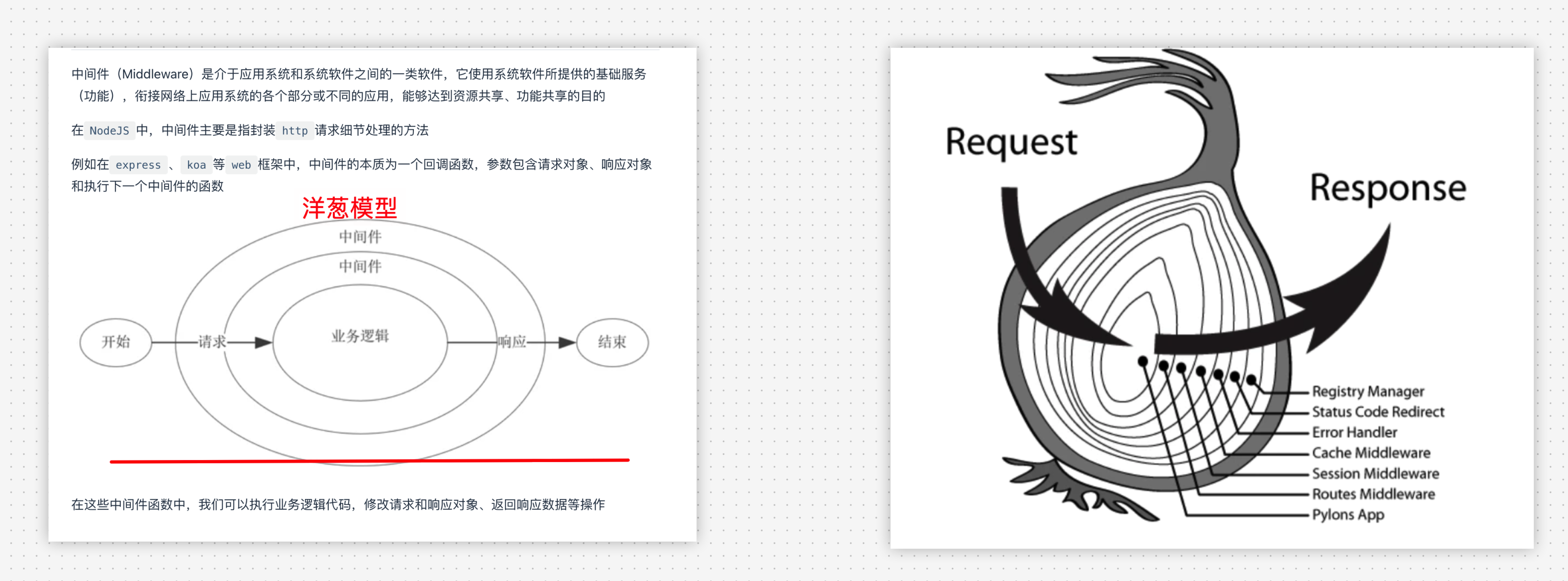Koa 的核心原理
#koa #nodejs #R1
Koa 是一个轻量级的 Node.js Web 框架
目录
1. 中间件机制与洋葱模型
Koa 最核心的特性是其中间件机制,采用洋葱模型(Onion Model)。这种模型的工作方式如下:


1.1. 中间件的核心实现原理
// 简化版的中间件实现原理
class Koa {
constructor() {
this.middleware = [];
}
use(fn) {
this.middleware.push(fn);
return this;
}
// 核心的中间件组合函数
compose(middleware) {
return function(context, next) {
let index = -1;
function dispatch(i) {
if (i <= index) {
return Promise.reject(new Error('next() called multiple times'));
}
index = i;
let fn = middleware[i];
if (i === middleware.length) fn = next;
if (!fn) return Promise.resolve();
try {
return Promise.resolve(fn(context, dispatch.bind(null, i + 1)));
} catch (err) {
return Promise.reject(err);
}
}
return dispatch(0);
};
}
}
1.2. 中间件机制(洋葱模型):示例
const Koa = require('koa');
const app = new Koa();
// 中间件1
app.use(async (ctx, next) => {
console.log('1 开始');
await next();
console.log('1 结束');
});
// 中间件2
app.use(async (ctx, next) => {
console.log('2 开始');
await next();
console.log('2 结束');
});
// 1 开始 -> 2 开始 -> 2 结束 -> 1 结束
2. Context 对象
Koa 的 Context 对象是请求的上下文,将 node 的 request 和 response 对象封装到单个对象中:
class Context {
constructor(req, res) {
this.req = req;
this.res = res;
this.state = {}; // 用于在中间件之间传递信息
// 代理 request 和 response 对象的属性
delegate(this, 'response')
.method('attachment')
.method('redirect')
.access('type')
.access('status');
delegate(this, 'request')
.method('acceptsLanguages')
.method('acceptsEncodings')
.access('querystring')
.access('socket');
}
}
3. 错误处理机制
Koa 提供了优雅的错误处理方式:
app.use(async (ctx, next) => {
try {
await next();
} catch (err) {
ctx.status = err.status || 500;
ctx.body = {
message: err.message
};
// 触发应用级错误事件
ctx.app.emit('error', err, ctx);
}
});
4. 异步流程控制
Koa 2.x 版本利用 async/await 来处理异步流程:
app.use(async (ctx, next) => {
const start = Date.now();
await next();
const ms = Date.now() - start;
console.log(`${ctx.method} ${ctx.url} - ${ms}ms`);
});
5. 请求和响应的封装
Koa 对 Node.js 原生的 req 和 res 对象进行了封装,形成了更易用的 Request 和 Response 对象:
class Request {
get header() {
return this.req.headers;
}
get method() {
return this.req.method;
}
get url() {
return this.req.url;
}
get query() {
const str = this.querystring;
return qs.parse(str);
}
}
class Response {
set type(type) {
this.set('Content-Type', type);
}
set body(val) {
this._body = val;
// 根据不同类型设置对应的 Content-Type
if (typeof val === 'string') this.type = 'text/plain';
if (Buffer.isBuffer(val)) this.type = 'application/octet-stream';
if (typeof val === 'object') this.type = 'application/json';
}
}
6. 工作流程
完整的 Koa 工作流程如下:

7. 主要特点总结
- 轻量级:
- 核心代码量很小,但扩展性强
- 中间件机制:
- 基于洋葱模型的优雅中间件机制
- 异步流程:
- 完美支持
async/await
- 完美支持
- 上下文封装:
- ==将 request 和 response 封装为单一的 context 对象==
- 错误处理:
- 统一的错误处理机制
- 无回调地狱:
- 通过 async/await 彻底解决回调问题